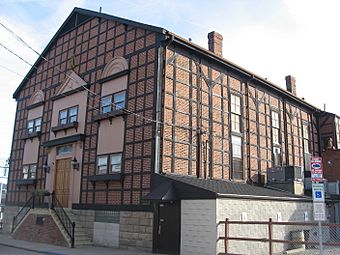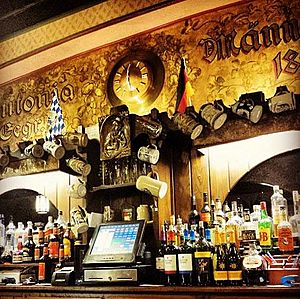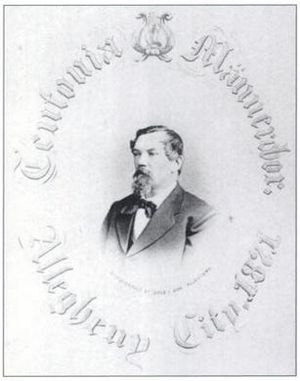Teutonia Maennerchor Hall facts for kids
|
Teutonia Männerchor Hall
|
|

Front and western side of the hall
|
|
| Location | 857 Phineas St., Pittsburgh, Pennsylvania |
|---|---|
| Area | less than one acre |
| Built | 1888 |
| Architect | Ott, George; Stripecke Brothers |
| Architectural style | Romanesque |
| NRHP reference No. | 04000439 |
Quick facts for kids Significant dates |
|
| Added to NRHP | May 14, 2004 |
The Teutonia Männerchor Hall is a special building in the Deutschtown neighborhood of Pittsburgh, Pennsylvania. It was built way back in 1888! This hall is home to the Teutonia Männerchor, which is a private club. Their main goals are to enjoy singing in a chorus, celebrate German traditions, and have good times together. The club often has fun activities and parties, including singing German songs and doing folk dances. In 2004, this historic building was added to the National Register of Historic Places, which means it's recognized as an important place in history.
Contents
History of the Teutonia Männerchor
The Teutonia Männerchor club started in 1854. It grew out of an older group called “Liederkranz,” which was founded in 1851 by Rev. Karl R. Weiterhausen. Later, Liederkranz changed its name to Freier Männerchor, and then to Teutonia Männerchor. The name "Teutonia" comes from one of the oldest German tribes. The Teutonia Männerchor is also part of a larger group called the Nord-Amerikanischer Sängerbund, which connects German singing clubs across North America.
Early Meeting Places
At first, the club met in the basement of an old Lutheran Church on Canal Street in Pittsburgh. In 1882, the chorus practiced in Dahlingers Hall. After that, they moved to the old Masonic Hall in what was then called Allegheny City.
Building the Hall
The club wanted its own place. So, on February 28, 1887, under President Henry Bergman, they bought the property of St. Peters Church on Pike Street (which is now Phineas Street). The club officially became a company on April 9, 1887. Soon after, the building you see today was constructed.
The building was designed by architect George Ott. The Stipecke Brothers were the contractors who built it. They used a special German building style called “Fachwerk” for the outside of the hall. This traditional look has been kept both inside and out, even today.
Opening and Celebrations
The first meeting in the new Hall was held on July 15, 1888. The Hall’s official opening party took place a few months later, on October 15, 1888. The decorations for the hall were provided by the Joseph Horne Company from Pittsburgh.
The club celebrated its 50th Anniversary in a big way on September 26 and 27, 1904. This celebration included a parade through the North Side of Pittsburgh.
Changes and Growth
In 1934, the first floor of the building, which is like a basement, was updated. Much of this work was done for free by club members. It was turned into a “Ratskeller” in a true German style. A Ratskeller is a type of restaurant or bar, often in a basement, with a traditional German feel.
For its 80th anniversary, the club decided to honor members who had been part of the club for 25 years. These members became honorary “Life Members.” This tradition continues today. In 1947, the club bought two houses next door to make the Hall even bigger.
The club celebrated its 100-year Centennial in 1954. On May 16, 1954, they held a big dinner in the upstairs Saengerhall (which means "singer's hall"). They also had a concert at Pittsburgh’s Carnegie Hall on June 12, 1954. At that time, the club had 897 members, including 65 singers in the Male Chorus and 45 singers in the Ladies Chorus.
In 1979, Teutonia celebrated its 125th Anniversary. For this event, seven German Coats of Arms were given to the club. These crests represent different areas of Germany and are now permanently displayed on the walls of the upstairs singer's hall.
Many improvements were made to the hall during the 1980s and 1990s. All the outside walls were fixed, and air conditioning was added to the upstairs singer's hall and kitchen. New equipment was also put in the bar. In recent years, members have even built an outdoor Biergarten next to the building. This is a fun outdoor area where club members can gather and socialize.






